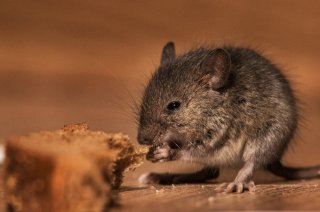
Showcase
Breath reveals how gut bacteria process food
Researchers of the Human and Animal Physiology chair group can monitor how the intestinal bacteria of mice process starch by analysing the air. They will use the data to improve their understanding of good nutrition and gut health.
People carry about some 0.2 kg of microbes. These are mainly bacteria, but also fungi, yeasts and viruses (together known as the microbiome). The intestines are the microbiome’s capital city; they are home to almost all of the 100 thousand billion microbes that live on and in our bodies.“The bacteria in the intestines play an important role in digestion, breaking down nutrients that the body cannot break down itself. However, sometimes the balance between good and bad bacteria is disrupted, which can result in illness,” says scientist and physiologist Dr Evert van Schothorst. “You could get Crohn’s disease or suffer from obesity. In the Human and Animal Physiology chair group, we monitor precisely how these microbiota interact with the food we eat. We will use the data to improve our knowledge of nutrition and gut health.”
Sensors measure day and night
The researchers are first carrying out measurements in mice and will move on to human subjects at a later stage. They serve the mice varying diets with different gradations in digestibility of the starch (carbohydrates), from easy to difficult to digest. Day and night, sensors measure which gases the mice breathe in and out after a meal: oxygen, carbon dioxide, methane or hydrogen. “Humans and rodents use starch, that is carbohydrates, as a source of energy,” explains Van Schothorst. “Our tests reveal that starch that is difficult to digest is immediately and rapidly fermented (broken down) by the intestinal bacteria in the large intestine. Easily digestible starch, on the other hand, has already been digested and absorbed as glucose. So the intestinal bacteria use the hard to digest starches as their own source of energy, which also means that less glucose is absorbed into the blood. This also has consequences for the energy balance of the mice, because less energy remains for the animals themselves. Hydrogen is released during this process which is exhaled by the mice.”
The researchers have also discovered that the intestinal bacteria have a cyclical activity pattern: the mice eat during the evening and night and then mainly burn carbohydrates. But as the night turns into day, they start burning more fatty acids. Because they no longer get their energy from their diet, they start using their reserves: fatty tissue is broken down and fatty acids are burned. “We know this because the sensors measure relatively less CO2 production and more O2 consumption. We even saw that thin mice burn relatively more fat from food than fat mice. The intestinal bacteria also remain active if the mice eat and sleep less, but at a reduced rate. We obtained all this information simply by monitoring the air.”
Breath test
The next step for the researchers of Human and Animal Physiology is to monitor the breathing of other groups of mice, such as older mice, and to study the effects of proteins in the diet. They also want to use the method on people. “Test chambers where researchers can measure people’s breathing already exist,” says Van Schothorst. In cooperation with Maastricht University, we plan to equip such chambers with special sensors to measure food digestion in real time. This is important because it will provide information about good nutrition, gut health and, in the future, diseases such as Crohn’s disease and obesity and related diabetes. In the near future, we may be able to quickly detect a problem in the intestines by carrying out a breath test, so our research will contribute to improving gut health.”